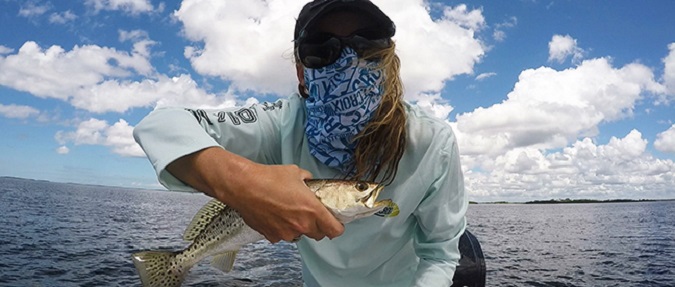Inshore opportunities abound throughout the Southeast, where anglers target a variety of species every month of the year. Possibly no location receives more attention than Florida’s fabled Mosquito Lagoon and the surrounding waters of the Indian River, where schools of redfish and trout, as well as marauding flounder and sheepshead, keep visiting anglers habitually casting in just inches of water. Hundreds of local captains guide on this stretch of the intracoastal, resulting in often-tough angling for educated fish.

Here, an simplified approach built around a few proven tactics is ever important. Popping corks take trout regularly on shallow flats, reds often can’t resist a flashy, gold spoon, and just about everything attacks a small paddle-tail swimmer. But the key component for all techniques starts with the cast.
In these pressured waters, long casts don’t just help anglers catch more fish, they’re necessary to catch any at all. Trolling around making short pitches to cover, using methods similar to bass fishing, simply doesn’t work for inshore species here. These super-sensitive fish feel the motion of the boat, hear the motor noise, and often dart away from incoming casts.
Successful guides and recreational fishermen spend hours on poling platforms around the Mosquito Lagoon area, looking for fish from afar to slide up on. The key is to use more wind, and less propulsion, to guide the boat, then quietly stake out or anchor down with a powered shallow water anchor. Once in place, ultra-long casts and limited splashes trick the fish.
While the lure often gets all the credit for a shallow-water bruiser, here, other components of the cast play just as vital of a role. Choosing the right rod, reel and line is critical to going long.
For starters, select an advanced braided fishing line. When spooled on spinning reels, braid casts nearly 100% further than any other form of fishing line. With proven microfiber braids like Seaguar Kanzen and Sufix 832, you can achieve 10-lb. strength with the diameter equivalent of 2-lb. monofilament. A short leader of abrasion-tough fluorocarbon in the seventeen-pound range will help with oyster bars and line-weary fish.
A standard 2500 size reel works fine for handling the braid, but be sure to load quite a bit, and resist taking up much spool space with backing. Long casts, coupled with drag-pulling tanks, often require much more line than your average freshwater excursion.
A high quality inshore rod is just as imperative as braided line to the long-cast system. The St. Croix’s Avid Inshore line-up covers the whole gamut, with models capable of launching the most discreet plastics, as well as the rowdiest topwaters.
Like all of St. Croix’s exceptional fishing tools, Avid Inshore fuses advanced components and rod-building technology with thoughtful craftsmanship. Betterment begins at the blank. The refreshed Avid Inshore is founded on an SCIII graphite blank – a blank born of St. Croix’s exclusive Integrated Poly Curve® (IPC®) tooling technology. The exclusive process yields continuous curve tapers, increased hoop strength and improved sensitivity. In short: These are the most sophisticated and best performing blanks in their class.
Raising the stakes, Avid Inshore features an enhanced guide platform with Kigan Master Hand Zero Tangle guides with solid-titanium frames for 100% protection from saltwater conditions. All thread wraps are protected by two coats of Flex Coat slow-cure finish as well.
Fuji® DPS reel seats with gunsmoke hoods deal a comfortable grip and solid foundation for casting reels. Avid Inshore spinning models sport trusted Fuji® ECS or TCS reel seats. Casting and spinning models double-down with super-grade cork handles tipped with corrosion-proof wind checks.
Rod lengths and powers in the Avid Inshore series are quite diverse. For skipping baits up under the mangroves, the 6’6” spinning models work nicely. Seven-foot-plus models launch spoons and handle popping corks and leaders with ease. Casting rod choices include 6 models covering 7’ – 8’ lengths in medium-heavy and heavy powers. And all come with IPC technology built in.
At the end of the day, the key to pressured fish is staying off their radar. They still swim and eat like normal members of class Pisces; they just don’t like people watching. A proper tackle system is necessary to fool inshore species by remaining unannounced through long casts.
Never let them know you’re there, and score like never before.



